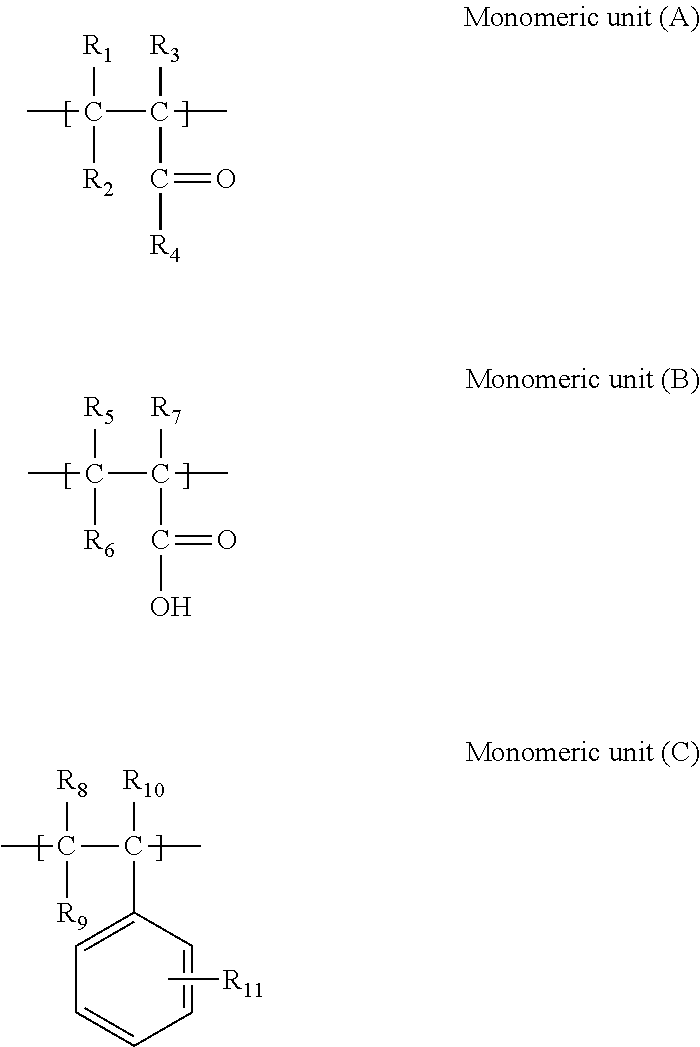Polymeric dye compound, photosensitive resin composition comprising same and use thereof
a technology of polymeric dye compound and resin composition, which is applied in the field of color liquid crystal display, can solve the problems of insufficient curing, decreased flowability of resin composition, and difficulty in color photosensitive resin composition, and achieves the effects of wide color reproduction area, high transmittance, and high brightness
- Summary
- Abstract
- Description
- Claims
- Application Information
AI Technical Summary
Benefits of technology
Problems solved by technology
Method used
Image
Examples
preparation example 1
Preparation of Pigment Dispersions PM-1 to PM-3
[0092]Pigment dispersions PM-1, PM-2 and PM-3 were prepared with reference to CN 102253599 B. The mixtures shown in the following table were uniformly mixed under stirring, dispersed in a mill (DYNO-MILL RESEARCH LAB, from WAB Machinery Co., Ltd.) for 5 hours in the presence of zirconia beads having a diameter of 0.5 mm, and then filtered through a filter having pores of 5.0 μm to give the pigment dispersions.
[0093]
PigmentPigmentAcrylicResinousdispersionpowderresindispersantSolventPM-1C.I. PigmentACAEFKA4300Propylene glycolRed 254Z25121 pbwmethyl ether acetate11 pbw20 pbw48 pbwPM-2C.I. PigmentACAEFKA4300Propylene glycolRed 177Z25121 pbwmethyl ether acetate11 pbw20 pbw48 pbwPM-3C.I. PigmentACAEFKA4300Propylene glycolYellow 150Z25121 pbwmethyl ether acetate11 pbw20 pbw48 pbw
[0094]In the following formulations of the respective photosensitive resin compositions prepared in the Examples (Ex.) and Comparative examples (CEX.), the amounts of ...
example 1
Synthesis of Polymeric Dye Compound a
[0099]1. To a three-necked flask containing methacryloyl chloride (10.45 g, 0.1 mol) was added 63.8 mL triethylamine, followed by the addition of Basic Red 9 (32.38 g, 0.1 mol). The mixture was reacted for 3 h, then filtered, and rotary evaporated to produce an amide compound, trimethacrylamide Basic Red 9.
[0100]2. A 1000 mL four-necked Erlenmeyer flask was provided with a nitrogen inlet, a stirrer, a heater, a condenser and a thermometer. With nitrogen gas being introduced into the flask, the components (i.e., the amide compound obtained in step 1 (0.1 mol), methacrylic acid monomer (0.35 mol), styrene monomer (0.3 mol), and the solvent ethyl 3-ethoxypropionate (EEP) 200 ml) were add in a batch under stirring. Then, with the contents of the flask being stirred, the temperature was increased to 100° C. by an oil bath. The polymerization initiator 2,2′-azobis-2-methylbutyronitrile (0.02 mol) was dissolved in 200 mL organic solvent EEP (solvent:pol...
example 2
Synthesis of Polymeric Dye Compound b
[0102]The polymeric dye compound b was synthesized according to the process of the polymeric dye compound a, with the exception that 0.3 mol o-vinyl toluene was used instead of the styrene monomer.
PUM
| Property | Measurement | Unit |
|---|---|---|
| temperature | aaaaa | aaaaa |
| temperature | aaaaa | aaaaa |
| temperature | aaaaa | aaaaa |
Abstract
Description
Claims
Application Information
 Login to View More
Login to View More - Generate Ideas
- Intellectual Property
- Life Sciences
- Materials
- Tech Scout
- Unparalleled Data Quality
- Higher Quality Content
- 60% Fewer Hallucinations
Browse by: Latest US Patents, China's latest patents, Technical Efficacy Thesaurus, Application Domain, Technology Topic, Popular Technical Reports.
© 2025 PatSnap. All rights reserved.Legal|Privacy policy|Modern Slavery Act Transparency Statement|Sitemap|About US| Contact US: help@patsnap.com



